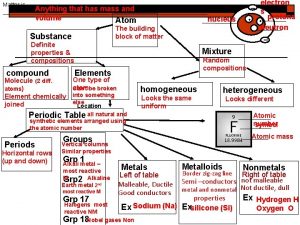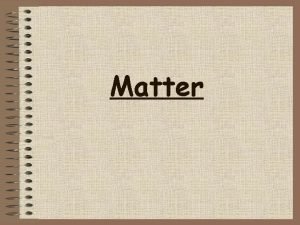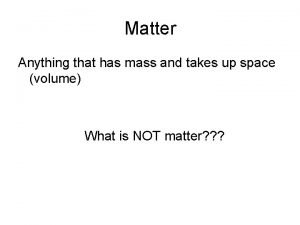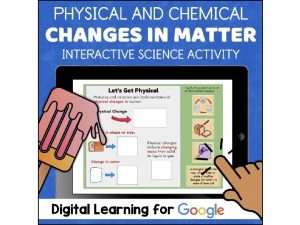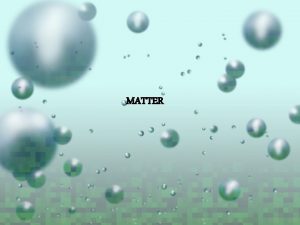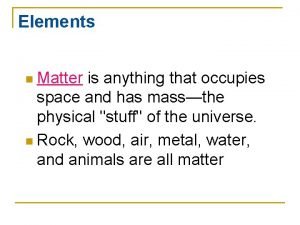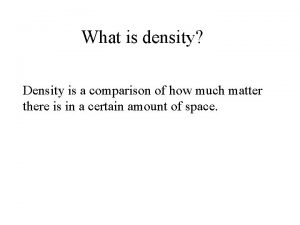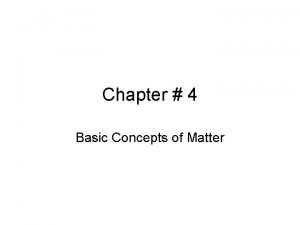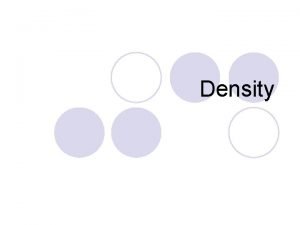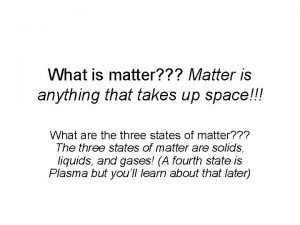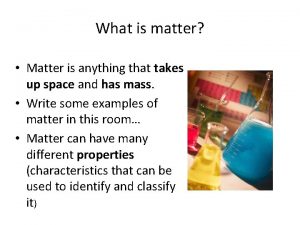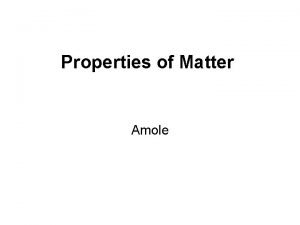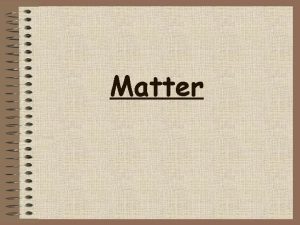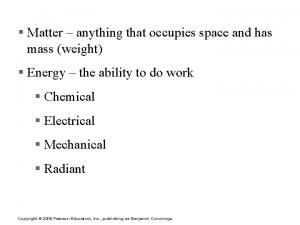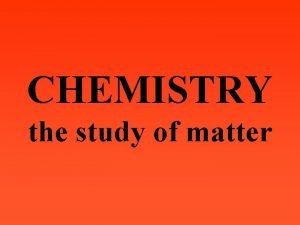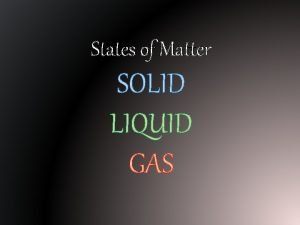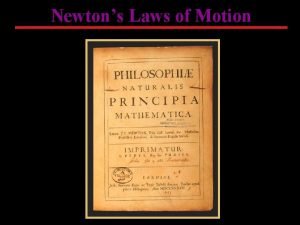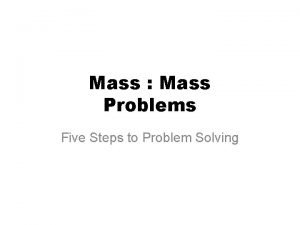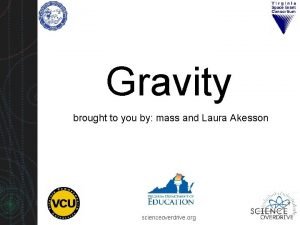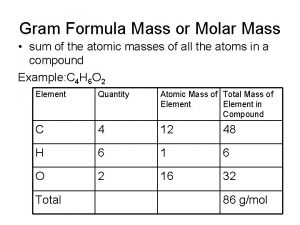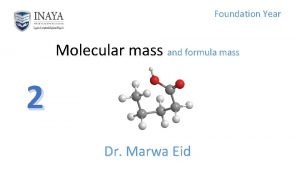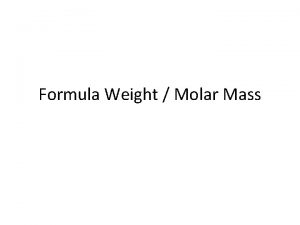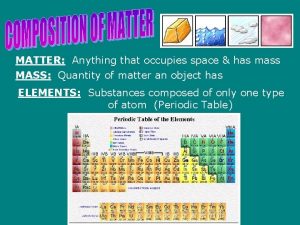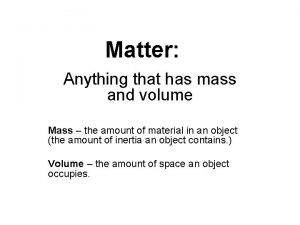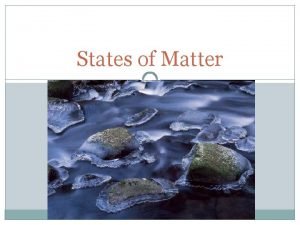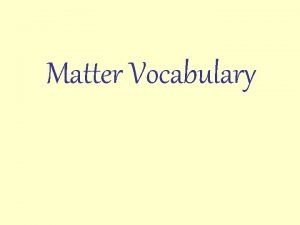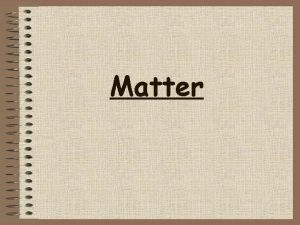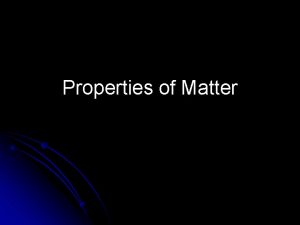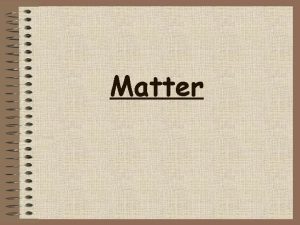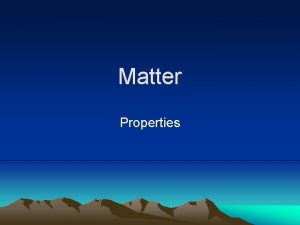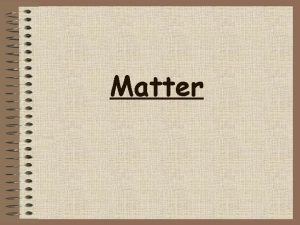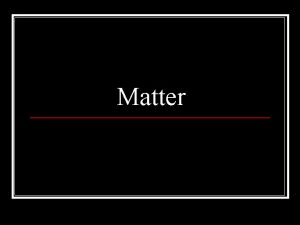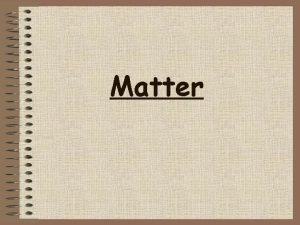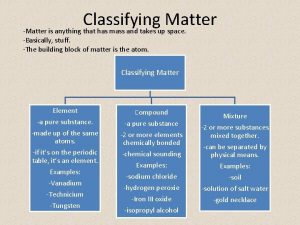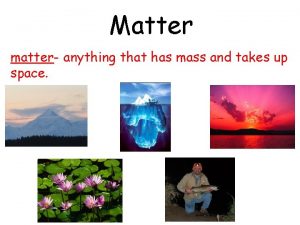Energy Matter Energy Matter anything that has mass


























































- Slides: 58

Energy & Matter

Energy & Matter - anything that has mass & takes up space ● Organisms use matter in chemical processes, such as digestion and breathing Energy - the ability to do work ● Enables organisms to use matter in life processes

Energy & Matter Law of conservation of mass ● Mass cannot be created or destroyed Law of conservation of energy ● Energy cannot be created or destroyed

Photosynthesis

Essential Questions: 1. How does radiant energy from the Sun change into chemical energy through the process of photosynthesis in a green plant? 2. How does the Law of Conservation of Mass relate to photosynthesis?

Sun’s Radiant Energy A form of kinetic energy Travels by waves or particles Makes life on Earth possible Moves through space Can be absorbed, transmitted, or reflected ● Visible light energy is vital for plants to make their own food. ● ● ● Electromagnetic spectrum

Why are Plants Green? ● Plants’ cells have chloroplasts, which contain the pigment chlorophyll. ● Chlorophyll absorbs most of the colors of the visible light spectrum except green, which is reflected. ● Notice that red is reflected from the flower and green from the leaf.

Three Reactants are Needed for a Green Plant to Make its Own Food 1. Energy from the Sun 2. Water and nutrients from the soil 3. Carbon Dioxide (CO 2) from the air This food-making process is called photosynthesis. This only occurs during the daylight hours. Let’s investigate further into how this process works.

Light Energy Chlorophyll ● ● ● Chloroplast The Sun or light from another source hits the leaves. The pigment chlorophyll (found in the chloroplasts) allows the plant to absorb the light energy. Only occurs in green leaves.

Water and Nutrients Two types of transport tissues: ● ● ● Xylem - transports water and nutrients from the roots to the leaves Phloem - transports food from the leaves to the rest of the plant These are found in vascular plants

Carbon Dioxide ● ● ● CO 2 enters the leaf through small openings called the stoma (plural: stomata) On either side of the stoma are guard cells, which control the opening and closing of the stoma. Green plants remove tons of CO 2 from the atmosphere.

You now know part of the equation for photosynthesis. What three things do green plants need to make their own food? Also, what are the structures in the leaf that allows for these needed things?

Equation ● The ingredients for making food in a green plant can be written in a chemical equation. ● The first part of the photosynthesis equation is written below. These ingredients are called the reactants because they cause a chemical reaction. Carbon Dioxide 6 CO 2 + Water 6 H 20 + energy from the sun Remember the small number represents the number of atoms, and the large number represents the number of molecules.

Two Products are made during Photosynthesis ● Sugar (in the form of glucose) ● Oxygen (Yay! Just what we need!) In a chemical equation these two things are the products of the chemical reaction. C 6 H 12 O 6 + 6 O 2 Sugar Oxygen Remember the small number represents the number of atoms, and the large number represents the number of molecules.

Glucose (sugar) ● Transported around the plant as soluble sugar ● Plants can turn glucose into starch for storage ● Cell walls in plants are made of starches ● Plants also use starches as a source of fuel C 6 H 12 O 6

CO 2 Oxygen ● Oxygen is a byproduct released during photosynthesis. ● The O 2 moves out of the plant through the stomata. ● The process of photosynthesis puts tons of oxygen back into our atmosphere. O 2

Name the 3 reactants in the photosynthesis formula.

Name the 2 products in the photosynthesis formula.


Directions 1. Cut out all the pieces. 2. Fold the top leaf along the dotted line so that the leaf can open up from the point (opposite the stem). 3. Glue the top leaf to the bottom leaf, but ONLY GLUE the half of the leaf that is nearest the stme. The other half of the leaf will open up to see the inside of the model. 4. Begin to glue the arrows.


Energy Pyramids

How is the flow of energy through an energy pyramid diagrammed?

Energy in a Living System ● All living things need energy. ● Energy made by plants (through photosynthesis) is transferred to an animal that eats it. ● The organism then transfers the energy to the next organism which eats it, and so on. ● A graphic representation of this system is called an Energy Pyramid.

How is an energy pyramid organized? Trophic Levels ● The feeding position in a food chain or energy pyramid that an organism occupies based on what it eats. ● Energy decreases from lower to higher trophic levels. ● Biomass (living or organic matter) decreases from lower to higher trophic levels.

What makes up an Energy Pyramid? Producers ● Get their energy from the Sun ● Make their own food through the process of photosynthesis ● Autotroph - makes its own food Producers

What makes up an Energy Pyramid? me nsu Co ● Unable to make its own food ● Heterotrophs - cannot make their own food, so they have to eat other things like plants or animals rs Consumers

Consumers P Co rima ns um ry ers Primary Consumers ● First to consume ● Herbivores - cannot make their own food - consume plants ● Heterotrophs

nd a Co ry an ns um d Te ers rtia ry Se Secondary and Tertiary Consumers ● Eat primary consumers and each other ● Carnivores - only eat other animals ● Heterotrophs co Consumers

Quaternary Consumers ● Apex predators ● Top of the food chain (animal on which nothing else preys) ● Carnivores ● Heterotrophs Qu Co ater ns na um ry ers Consumers

What makes up an Energy Pyramid? Decomposers ● Garbage man of ecosystems ● Active at each level of the pyramid ● Break down dead organisms and return its nutrients back to the environment

Energy Pyramid Labeling 1. In your guided notes, color each of the squares � ( ) a different color. 2. For each square, color and label each level of your pyramid to correspond to the correct trophic level.

Energy Pyramids An energy pyramid’s shape shows how the amount of useful energy that enters each level (chemical energy in the form of food) decreases as it is used by the organisms in that level.

How does energy flow through an energy pyramid? ● Amount of energy in every level decreases by about 10% as you go up the pyramid. ● Measured in kilocalories (Kcal) or Joules (J) ● 1 Kcal = 4184 Joules (J)

If an energy pyramid starts with 1000 J of energy, calculate the energy available for each level. _J ___J 1000 J

_J Now try starting with 5500 J. ___J 5500 J

Where does the energy go? ● Remember energy cannot be destroyed. ● Energy is used up by the animals metabolic processes, running, eating, finding mates, escaping danger daily living. ● Given off to the environment as heat.

The consumers at the top of a food pyramid have much less energy available to support them than those closer to the bottom. That is why their numbers are relatively few. Eventually, the amount of useful energy left cannot support another level. Rarely more than 4 trophic levels!

Can you describe how energy flows through an energy pyramid?

Food Webs & Food Chains

1. How can you diagram the energy flow through a living system? 2. How would you describe food webs in different ecosystems?

Food Chain ● A single pathway in which energy and nutrients are passed from one living organism to another. ● Energy is used up as it moves up the food chain. ● The arrow represents energy being transferred.

Food Web ● A network of food chains by which energy and nutrients are passed on from one living organism to another. ● Multiple pathways ● The arrows represent energy being transferred. ● Energy is greatest at the bottom of the food web.

Review: Energy Pyramid ● Graphical model of energy flow in a community ● Where is the energy lowest? ● Where is the population smallest?

Vocabulary review: Producers

Vocabulary review: Consumers

Vocabulary review: Decomposers

Vocabulary review: Herbivores

Vocabulary review: Carnivores

Vocabulary review: Omnivores

Vocabulary review: Scavengers

Vocabulary review: Producer Primary Consumer Secondary Consumer Tertiary Consumer Quaternary Consumer

Deep Ocean Food Webs ● No sunlight reaches the deep ocean floor, but still there is life. ● In these extreme environments, energy comes from two places: ○ Cold seeps ○ Hydrothermal vents This process is called chemosynthesis

Cold Seeps ● Areas where methane and hydrogen sulfide are released into the ocean. ● Certain single-celled organisms (microbes) live off these gases. ● Clams, mussels, shrimp, crabs, bacteria, and tubeworms eat these microbes for food.

Hydrothermal Vents ● Water is heated by underwater volcanic activity. ● Hot water spews from holes in the crust called vents. ● Microbes turn the chemicals in the hot water into energy. ● Fish, shrimp, giant tubeworms, mussels, crabs, and clams live on these microbes.

Can you… 1. Diagram the energy flow through a living system? 2. Describe food webs in different ecosystems?

Project Checkpoints Step 1 (including environment research for paragraph 1) → February 14 Step 2 → February 16 Step 3 → February 21 Step 4 → February 23 Step 5 → February 28 Step 6 (& complete project) → March 2

Writing Prompt: Explain how energy moves through each of the trophic levels in an energy pyramid.
 This is anything with mass that occupies space
This is anything with mass that occupies space Matter is anything with mass and volume
Matter is anything with mass and volume Anything that has mass and takes up space is
Anything that has mass and takes up space is Anything that has mass and take up space
Anything that has mass and take up space Matter is anything that...
Matter is anything that... It is anything that has mass and occupies space
It is anything that has mass and occupies space Matter has mass and occupies space
Matter has mass and occupies space Matter anything that
Matter anything that Whats anything that has mass and takes up space
Whats anything that has mass and takes up space Anything that has mass and takes up space
Anything that has mass and takes up space No matter anything
No matter anything Whats anything that has mass and takes up space
Whats anything that has mass and takes up space Anything that takes up space and has mass
Anything that takes up space and has mass Physical properties defintion
Physical properties defintion Anything that has matter and takes up space
Anything that has matter and takes up space Matter is anything that occupies space and has
Matter is anything that occupies space and has Phân độ lown
Phân độ lown Block xoang nhĩ độ 2 type 1
Block xoang nhĩ độ 2 type 1 Thể thơ truyền thống
Thể thơ truyền thống Thơ thất ngôn tứ tuyệt đường luật
Thơ thất ngôn tứ tuyệt đường luật Walmart thất bại ở nhật
Walmart thất bại ở nhật Tìm độ lớn thật của tam giác abc
Tìm độ lớn thật của tam giác abc Con hãy đưa tay khi thấy người vấp ngã
Con hãy đưa tay khi thấy người vấp ngã Tôn thất thuyết là ai
Tôn thất thuyết là ai Gây tê cơ vuông thắt lưng
Gây tê cơ vuông thắt lưng Sau thất bại ở hồ điển triệt
Sau thất bại ở hồ điển triệt Frank has an eraser it has a mass of 4g
Frank has an eraser it has a mass of 4g Matter is defined as anything that
Matter is defined as anything that Matter anything that
Matter anything that Is oil more dense than water
Is oil more dense than water Matter is anything that:
Matter is anything that: What is the opposite of sublimation?
What is the opposite of sublimation? No matter anything
No matter anything Matter is anything that
Matter is anything that Dmv formula
Dmv formula Matter anything that
Matter anything that Matter anything that
Matter anything that Matter anything that
Matter anything that Matter anything that
Matter anything that Energy naturally flows from warmer matter to cooler matter
Energy naturally flows from warmer matter to cooler matter Dull would he be of soul who could pass by figure of speech
Dull would he be of soul who could pass by figure of speech Which state of matter has the most thermal energy
Which state of matter has the most thermal energy Mass to mass formula
Mass to mass formula Atomic mass
Atomic mass Relative formula mass of hcl
Relative formula mass of hcl How to calculate percent by mass
How to calculate percent by mass Inertial mass vs gravitational mass
Inertial mass vs gravitational mass Grams to moles
Grams to moles Convert grams to moles
Convert grams to moles Mass/molar mass
Mass/molar mass Mole to particles
Mole to particles Units for molar mass
Units for molar mass Mass/mass problems
Mass/mass problems Difference between atomic number and atomic mass
Difference between atomic number and atomic mass Gravitational mass vs inertial mass
Gravitational mass vs inertial mass Formula mass
Formula mass Molecular mass
Molecular mass Units for formula mass
Units for formula mass Formula mass vs molar mass
Formula mass vs molar mass

